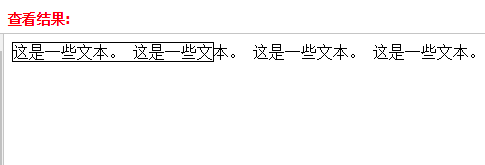不值一提,却又不得不提的“CSS文本超出部分省略号代替” - 生旦净末丑
偶然看到一篇类似css技巧与经验总结的文章,其中有一部分非常熟悉,那就是“css控制元素内文本超出部分使用省略号代替”,一般实际工作中,
很多产品经理会对页面UI有这样的要求。还记得,第一次做这个功能时,是通过百度到的,然后就是一劳永逸,直接记事本记录下来,以后基本上
就是拿来主义,根本就没有去研究一下其中的原理(其实也没什么原理,方法也很简单,O(∩_∩)O哈哈~),恰逢今日又碰到了,那就做个了断吧。
实现如题的功能,我们常用的代码如下:
<span style="color: #800000;">p</span>{<span style="color: #ff0000;">
width</span>:<span style="color: #0000ff;"> 100px</span>;<span style="color: #ff0000;">
white-space</span>:<span style="color: #0000ff;"> nowrap</span>;<span style="color: #ff0000;">
overflow</span>:<span style="color: #0000ff;"> hidden</span>;<span style="color: #ff0000;">
text-overflow</span>:<span style="color: #0000ff;"> ellipsis</span>;
}这里P标签的4个css属性都是必要的,这些属性都起到什么作用呢?
width:用于设置p标签的宽度,如果没有宽度,何为“超出”,对吧?即使是没有手动的为p标签设定宽度,那么p标签横向也会自动充满父元素,也就是所说的100%;
white-space:这个属性不得了,特别值为“nowrap”的时候,为何这么说呢,因为当块级元素内的文本如果超过一行,即多行时,文本默认是要换行的,绝不会出现溢出
的情况;但是如果元素设置了这个属性white-space:nowrap,那么文本会无视父元素的宽度限制,结果就是文本溢出,如下图:

结果就是这样,你说它牛叉不牛叉。
overflow:该属性是告诉元素,如果它内部包含的元素(图片、文本、其他元素等等)超出它的长宽范围时该如何处理,是显示滚动条呢,还是隐藏超出部分呢?而我们
当前所说的案例是需要超出的文本被隐藏,所以我们设置overflow:hidden。
text-overflow:这个属性是CSS3的新属性,下面是官方解释:

我们需要把它的值设为ellipsis,该值的意思就是以省略号代替超出的文本部分。
4个属性值组合起来使用,最后达到了这样的效果:
代码

运行结果

结语:希望此篇文章可以对像我一样“拿来主义”的童鞋们有所帮助

Hot AI Tools

Undresser.AI Undress
AI-powered app for creating realistic nude photos

AI Clothes Remover
Online AI tool for removing clothes from photos.

Undress AI Tool
Undress images for free

Clothoff.io
AI clothes remover

AI Hentai Generator
Generate AI Hentai for free.

Hot Article

Hot Tools

Notepad++7.3.1
Easy-to-use and free code editor

SublimeText3 Chinese version
Chinese version, very easy to use

Zend Studio 13.0.1
Powerful PHP integrated development environment

Dreamweaver CS6
Visual web development tools

SublimeText3 Mac version
God-level code editing software (SublimeText3)

Hot Topics
 Difficulty in updating caching of official account web pages: How to avoid the old cache affecting the user experience after version update?
Mar 04, 2025 pm 12:32 PM
Difficulty in updating caching of official account web pages: How to avoid the old cache affecting the user experience after version update?
Mar 04, 2025 pm 12:32 PM
The official account web page update cache, this thing is simple and simple, and it is complicated enough to drink a pot of it. You worked hard to update the official account article, but the user still opened the old version. Who can bear the taste? In this article, let’s take a look at the twists and turns behind this and how to solve this problem gracefully. After reading it, you can easily deal with various caching problems, allowing your users to always experience the freshest content. Let’s talk about the basics first. To put it bluntly, in order to improve access speed, the browser or server stores some static resources (such as pictures, CSS, JS) or page content. Next time you access it, you can directly retrieve it from the cache without having to download it again, and it is naturally fast. But this thing is also a double-edged sword. The new version is online,
 How to efficiently add stroke effects to PNG images on web pages?
Mar 04, 2025 pm 02:39 PM
How to efficiently add stroke effects to PNG images on web pages?
Mar 04, 2025 pm 02:39 PM
This article demonstrates efficient PNG border addition to webpages using CSS. It argues that CSS offers superior performance compared to JavaScript or libraries, detailing how to adjust border width, style, and color for subtle or prominent effect
 How do I use HTML5 form validation attributes to validate user input?
Mar 17, 2025 pm 12:27 PM
How do I use HTML5 form validation attributes to validate user input?
Mar 17, 2025 pm 12:27 PM
The article discusses using HTML5 form validation attributes like required, pattern, min, max, and length limits to validate user input directly in the browser.
 What is the purpose of the <datalist> element?
Mar 21, 2025 pm 12:33 PM
What is the purpose of the <datalist> element?
Mar 21, 2025 pm 12:33 PM
The article discusses the HTML <datalist> element, which enhances forms by providing autocomplete suggestions, improving user experience and reducing errors.Character count: 159
 What is the purpose of the <progress> element?
Mar 21, 2025 pm 12:34 PM
What is the purpose of the <progress> element?
Mar 21, 2025 pm 12:34 PM
The article discusses the HTML <progress> element, its purpose, styling, and differences from the <meter> element. The main focus is on using <progress> for task completion and <meter> for stati
 What is the purpose of the <meter> element?
Mar 21, 2025 pm 12:35 PM
What is the purpose of the <meter> element?
Mar 21, 2025 pm 12:35 PM
The article discusses the HTML <meter> element, used for displaying scalar or fractional values within a range, and its common applications in web development. It differentiates <meter> from <progress> and ex
 What are the best practices for cross-browser compatibility in HTML5?
Mar 17, 2025 pm 12:20 PM
What are the best practices for cross-browser compatibility in HTML5?
Mar 17, 2025 pm 12:20 PM
Article discusses best practices for ensuring HTML5 cross-browser compatibility, focusing on feature detection, progressive enhancement, and testing methods.
 What is the purpose of the <iframe> tag? What are the security considerations when using it?
Mar 20, 2025 pm 06:05 PM
What is the purpose of the <iframe> tag? What are the security considerations when using it?
Mar 20, 2025 pm 06:05 PM
The article discusses the <iframe> tag's purpose in embedding external content into webpages, its common uses, security risks, and alternatives like object tags and APIs.






